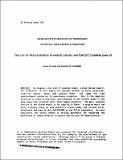| dc.contributor.author | Vaina, Lucia M. | |
| dc.contributor.author | Greenblatt, Richard D. | |
| dc.date.accessioned | 2008-04-02T15:59:31Z | |
| dc.date.available | 2008-04-02T15:59:31Z | |
| dc.date.issued | 1979-09-05 | |
| dc.identifier.uri | http://hdl.handle.net/1721.1/41041 | |
| dc.description.abstract | We propose a new type of semantic memory, called thread memory. The primitives of this memory are threads, defined as keyed multilink, loop-free chains, which link semantic nodes. All links run from superordinate categories to subordinate categories. This is the opposite direction to those in the usual tree structure in that brother nodes in the tree share the structure above their common ancestors. The most valuable feature of the thread memory is its capacity to learn. A program which can learn concepts using as data children's primer books, was written by R. Greenblatt and runs on the LISP-MACHINE at the MIT-AI Laboratory. We have considered the thread memory as working hypothesis for exploring the mechanisms of naming deficits in aphasia and the ways of rehabilitation. | en |
| dc.description.sponsorship | MIT Artificial Intelligence Laboratory | en |
| dc.language.iso | en_US | en |
| dc.publisher | MIT Artificial Intelligence Laboratory | en |
| dc.relation.ispartofseries | MIT Artificial Intelligence Laboratory Working Papers, WP-195 | en |
| dc.title | The Use of Thread Memory in Amnesic Aphasia and Concept Learning.(note 0) | en |
| dc.type | Working Paper | en |
